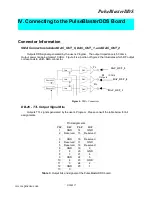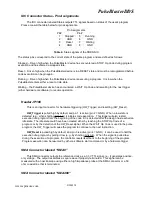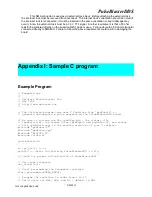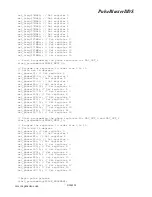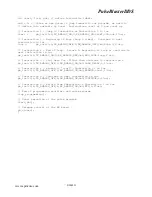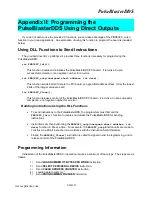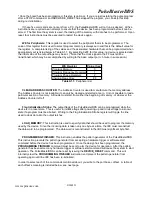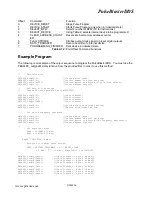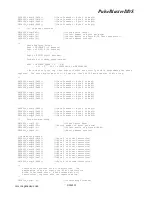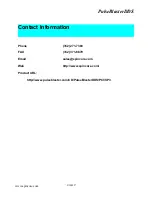
PulseBlasterDDS
* Once the board has been programmed, this step is optional. If you are just restarting the pulse program
after a STOP command or an HARDWARE_RESET has stopped the program, you can skip this step
during re-initialization.
If these five commands are not sent from a PC, the PulseBlasterDDS will not run as desired. All five
instructions are required as an attempt to ensure that the device has been programmed before it can be
armed. The first time the system is used, the loading of the memory with data has to be performed. Upon
reset, four instructions must be executed to restart the device again.
WE for Peripherals:
This register is used to select the peripheral that is to be programmed. The
value of this register that is used to select program memory is always zero and this is the default value for
the register. A complete listing of the values and the associated hardware that can be programmed when
appropriately set is listed below in Table A1.1. By selecting 0xFF for this value, no device is selected and
the initial value of the output flags may be set. (*Note that the clock signal to the FF must still be
transitioned, which may be accomplished by writing to the base output port + 5 twice in succession.)
WE Register
Value (hex)
Program Memory
0
Program Frequency Registers
1
Program Phase Registers
2
Change Flags Only
FF
Table A1.1:
Peripheral List
CLEAR ADDRESS COUNTER:
The Address Counter is used to manufacture the memory address.
The Address Counter is not loadable; it can only be cleared and started at zero. It is not possible to load a
particular section of memory. All loads must start from either the beginning of memory, or wherever the
Address Counter left off.
Flag Initialization Strobe:
The output flags of the PulseBlasterDDS can be programmed while the
device is in a reset state. This is useful to initialize flags after powering-up and to reset flags to a known
state if a program must be aborted. Writing to the Flag Initialization Strobe register will toggle the line
used to clock data into the output latches.
LOAD_MEMORY:
This instruction is used to specify data that should be used to program the memory
used by the device. Since the incoming data is taken only one byte at a time, the IBC must reconstruct
the data word to be programmed. The data word is reconstructed in the IBC most significant byte first.
PROGRAMMING FINISHED:
This instruction enables the pattern generator of the PulseBlasterDDS.
This instruction prevents the pattern generator from accepting a hardware trigger or software start
command before the device has been programmed. Once the design has been programmed, the
PROGRAMMING FINISIHED
command must be sent to arm the device for operation. After the pattern
generator has been armed, any hardware trigger or software start command will cause the system to start
operation. The PulseBlasterDDS can be reset by issuing the
DEVICE_RESET
command. This will
internally clear the
PROGRAMMING FINISHED
instruction and prevent the pattern generator from
operating again until the IBC has been re-initialized.
In order to select each of the commands mentioned about, you write to the port base + offset. A table of
each offset’s meaning is included below, see next page.
9/20/200523
www.spincore.com









